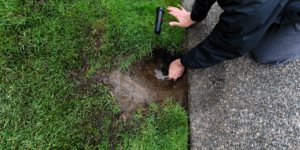Hello and welcome to our blog on fire sprinkler installation in building design. Imagine a fast-spreading fire in a commercial or residential building. Chaos, panic, and damage may be devastating. But what if calamities could be avoided? Fire sprinkler systems—silent heroes who have saved lives and property for centuries.
The Basics of Fire Sprinkler Systems
Sprinkler systems are essential to structure fire safety. These systems use a network of pipes strategically placed throughout the building with sprinkler heads that activate from heat or smoke. When activated, these heads spray water or other extinguishers to put out fires.
Fire sprinkler activation features distinguish them. Instead of evacuating the building, sprinkler heads activate only when heat is applied. If a fire starts, the device will solely target the flames.
Effective fire sprinkler systems depend on their design and placement. The spacing between sprinkler heads must meet industry standards for efficient coverage and fast response. Based on occupancy load, danger rating, and architectural elements, various buildings may require different system requirements.
The History and Evolution of Fire Sprinklers
Fire sprinklers have a rich history extending back to prehistoric civilizations. While technology has advanced, the goal has remained the same: to identify and extinguish flames before they do harm.
Ancient Rome is where fire sprinklers first appeared. Early systems employed hollowed-out log pipelines to release water when heated by flames. throughout the 17th century, gunpowder-powered hand-operated devices were invented throughout Europe.
Henry S. Parmelee invented one of America’s earliest automatic sprinkler systems in the 19th century. He used fusible linkages that melted at high temperatures, releasing water over the flames.
Fire safety advances increased throughout time. Frederick Grinnell developed a heat-shattering glass disc sprinkler head in 1881. This accelerated response times and improved firefighting.
Technological advances made fire sprinkler systems efficient and reliable life-saving equipment. Modern systems use sophisticated sensors to instantly detect smoke or heat and activate sprinklers in impacted areas.

Benefits of Fire Sprinkler Installation in Building Design
Fire sprinklers in building designs have several benefits beyond fire protection. Modern buildings need these systems to protect people.
A major benefit is the ability to quickly extinguish a fire before it spreads and causes extensive damage. In high temperatures, fire sprinklers quickly spray water on fires. This quick response can reduce property damage and save lives.
In addition, fire sprinklers protect precious building assets. This added layer of protection can preserve valuable goods including expensive equipment, documents, and antiques.
Factors to Consider When Installing Fire Sprinklers
Several variables must be considered before putting fire sprinklers in a structure. Building layout comes first. The space’s design and configuration will dictate sprinkler placement for best coverage and efficacy.
Also crucial is the building’s occupancy or use. Fire threats vary by occupancy type, thus it’s important to examine them.
Sprinkler location also depends on building size and height. Taller buildings may need sprinkler systems on higher stories and several zones for coverage.
Water supply is also important. An effective fire sprinkler system requires sufficient water pressure and flow. This may require collaboration with local authorities or water providers to secure supply.
Common Myths About Fire Sprinkler Systems
Sprinkler system fire safety myths abound. These falsehoods can mislead and endanger lives. Let’s dispel fire sprinkler myths.
Myth: All sprinklers in a structure activate simultaneously in a fire. Actually, each sprinkler head activates separately when it detects fire heat. This activates only the sprinklers nearest to the fire, reducing water damage and allowing people in other sections of the building to escape safely.
Misconception: smoke detectors alone prevent fires. Sprinklers can suppress fires, but smoke detectors are essential. Fire sprinklers can quickly put out small fires.
Automatic fire sprinklers may leak water or activate accidentally, according to some. Due to strict manufacturing standards and professional inspections, these events are rare.
Cost and Maintenance of Fire Sprinkler Systems
Installing a fire sprinkler system may appear expensive for fire safety. When considering fire damage, the expenditure is justified. Building size and complexity affect installation costs.
Low-maintenance fire sprinkler systems need regular inspections and maintenance to work properly. A certified specialist should evaluate these systems annually to spot problems. Maintenance keeps the system ready for emergencies.
A widespread misperception is that fire sprinkler system maintenance is expensive, yet routine maintenance expenditures are low compared to fire damages. These frequent inspections and repairs are crucial to building safety, so budget for them.
Insurance rates also affect fire sprinkler system costs. Because sprinklers reduce fire damage, many insurance companies offer discounts for buildings with properly installed and maintained sprinklers.
Modern technologies in your fire protection system can boost advantages and lower expenses. Advanced monitoring systems can quickly discover leaks and malfunctions, lowering repair costs.
Installing and maintaining fire sprinkler systems is worth the original and continuing costs to prevent uncontrolled fires. Regular inspections and rapid repairs maintain compliance with regulations and improve building safety.

Conclusion
Fire sprinkler systems defend lives and property in today’s world of building safety. These clever technologies have become efficient and trustworthy over time. Fire sprinklers can reduce fire damage and improve building design.
Fire sprinklers are essential. They quickly extinguish fires. Early intervention gives inhabitants more time to escape, saving lives.
Installing fire sprinklers in buildings requires careful consideration of numerous variables. To cover all areas, structure size, and layout must be considered. Local building codes must be followed.
Architects, engineers, and building owners must work together throughout design to ensure fire sprinkler systems integrate seamlessly with other mechanical components without compromising aesthetics or functionality.
Fire sprinkler systems are useful, yet there are fallacies about them. In contrast to popular assumption, operating one sprinkler head does not activate all heads at once unless essential. Only heads near heat or smoke trigger fire detection sensors.
